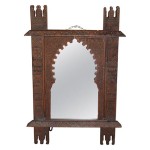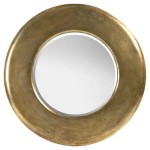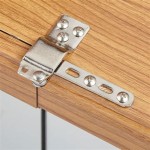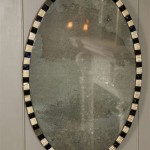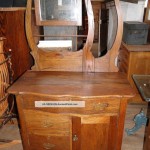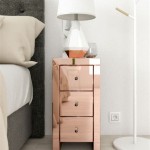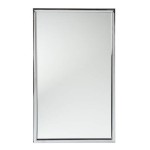```html
The Comprehensive Guide to Hanging Tri-Fold Mirrors
Tri-fold mirrors, also known as triptych mirrors, offer a multifaceted perspective, making them invaluable for various tasks, ranging from applying makeup and styling hair to assessing outfits and evaluating posture. Their ability to display front, side, and back reflections simultaneously provides a significant advantage over single-panel mirrors. Hanging a tri-fold mirror can significantly enhance the functionality and aesthetic appeal of a dressing room, bedroom, or even a bathroom, provided it is done correctly and securely.
This article aims to provide a comprehensive understanding of the process involved in hanging a tri-fold mirror. It will cover essential considerations before installation, including selecting the right mirror size and style, evaluating wall suitability, and gathering necessary tools and materials. Furthermore, it will detail step-by-step instructions for the hanging process, emphasizing safety precautions and offering troubleshooting tips for common challenges encountered during installation. Properly installed, a hanging tri-fold mirror can become a long-lasting and highly functional addition to any space.
Key Considerations Before Hanging Your Tri-Fold Mirror
Before commencing the installation, several factors necessitate careful evaluation to ensure a successful and satisfactory outcome. These considerations include the mirror's dimensions, the wall's structural integrity, and the planned usage of the mirror within the space.
Mirror Size and Style: The size and style of the tri-fold mirror should be carefully chosen to complement the dimensions of the room and the overall decor. A large, ornate mirror might overwhelm a small space, while a small, minimalist mirror might appear insignificant in a larger room. The style of the mirror's frame, whether it is modern, traditional, or rustic, should also align with the existing aesthetic of the room. Consider the mirror's primary function. For makeup application, a mirror with integrated lighting may be preferable. For full-body outfit assessment, a taller mirror is generally more suitable. The weight of the mirror is also a crucial factor, especially when considering the wall type and load-bearing capacity.
Wall Suitability: The type of wall on which the mirror will be hung is paramount. There are typically three main types of walls: drywall, plaster, and solid masonry (brick or concrete). Drywall is the most common wall type and is generally the least sturdy. Plaster walls are more durable than drywall but can be prone to crumbling. Solid masonry walls are the strongest but can be more challenging to drill into. Identify the wall type and assess its condition. Look for any signs of damage, such as cracks, holes, or water stains, which could compromise the wall's structural integrity. If the wall is damaged, repairs should be made before proceeding with the installation. For heavier mirrors, locating wall studs is critical. Wall studs are vertical framing members within the wall that provide significant support. Hanging the mirror directly on the studs will ensure maximum stability and prevent the mirror from falling down. A stud finder can be used to locate the studs accurately.
Planned Usage and Placement: Consider how the mirror will be used. Will it be primarily for applying makeup, styling hair, or assessing outfits? The intended use will influence the optimal height and placement of the mirror. For makeup application, the center panel of the mirror should be positioned at eye level when seated. For full-body assessment, the mirror should be tall enough to reflect the entire body. Ensure adequate lighting in the area where the mirror will be hung. Natural light is ideal, but if natural light is limited, consider adding artificial lighting to illuminate the mirror and the surrounding area. Also, consider the proximity of electrical outlets if the mirror has integrated lighting. The placement of the mirror should also take into account potential obstructions, such as furniture or doorways. Ensure that there is enough space around the mirror to allow for comfortable use and to prevent accidental damage.
Essential Tools and Materials for Hanging Your Tri-Fold Mirror
Having the right tools and materials readily available will streamline the installation process and ensure a secure and professional-looking result. The specific tools and materials required will vary depending on the type of wall and the weight of the mirror, but the following list provides a general overview of the essential items.
Measuring Tools: A measuring tape is essential for determining the precise location where the mirror will be hung. A level is crucial for ensuring that the mirror is hung straight. A pencil is needed for marking the wall to indicate the mounting points.
Drilling and Fastening Tools: A drill is necessary for creating pilot holes for screws or anchors. The type of drill bit required will depend on the wall type. For drywall, a standard drill bit is sufficient. For plaster, a masonry drill bit may be necessary. For solid masonry, a hammer drill with a masonry drill bit is essential. A screwdriver is needed for tightening screws. A variety of screws and anchors will be required, depending on the weight of the mirror and the type of wall. For drywall, drywall anchors are recommended. For plaster, plaster anchors are needed. For solid masonry, masonry screws or anchors are essential. If the mirror comes with its own mounting hardware, ensure that the hardware is appropriate for the wall type.
Safety Equipment: Safety glasses are essential for protecting the eyes from debris while drilling. Work gloves will provide a better grip and protect the hands. A dust mask is recommended to prevent inhalation of dust and particles.
Other Helpful Items: A stud finder will help locate wall studs for added support. Painter's tape can be used to mark the location of the mirror and to protect the wall from scratches. A vacuum cleaner will help clean up any dust or debris generated during the installation process.
Step-by-Step Instructions for Hanging a Tri-Fold Mirror
Once the preliminary considerations are addressed and the necessary tools and materials are gathered, the following steps will guide the hanging process. It is imperative to prioritize safety and accuracy throughout the installation.
Step 1: Prepare the Wall: Clean the area where the mirror will be hung to remove any dust, dirt, or debris. If the wall is painted, make sure the paint is dry and fully cured. Use painter's tape to mark the outline of the mirror on the wall. This will help visualize the placement and prevent accidental damage to the wall.
Step 2: Locate Wall Studs (if applicable): If the mirror is heavy, use a stud finder to locate the wall studs. Mark the location of the studs with a pencil. Ideally, the mirror should be hung directly on the studs for maximum support. If it is not possible to hang the mirror directly on the studs, use appropriate anchors that are designed for the wall type and the weight of the mirror.
Step 3: Mark Mounting Points: Measure the distance between the mounting points on the back of the mirror. Transfer these measurements to the wall, using the level to ensure that the mounting points are horizontally aligned. Use a pencil to mark the exact location of the mounting points on the wall.
Step 4: Drill Pilot Holes: Using the appropriate drill bit for the wall type, drill pilot holes at the marked mounting points. The pilot holes should be slightly smaller than the diameter of the screws or anchors that will be used. For drywall, use a drill bit that is slightly smaller than the diameter of the drywall anchors. For plaster, use a masonry drill bit that is slightly smaller than the diameter of the plaster anchors. For solid masonry, use a hammer drill with a masonry drill bit that is slightly smaller than the diameter of the masonry screws or anchors.
Step 5: Install Anchors (if necessary): If the mirror is not being hung directly on the studs, install appropriate anchors in the pilot holes. For drywall, insert the drywall anchors into the pilot holes and tap them gently with a hammer until they are flush with the wall. For plaster, insert the plaster anchors into the pilot holes and twist them until they are securely in place. For solid masonry, insert the masonry screws or anchors into the pilot holes and tighten them with a wrench or screwdriver.
Step 6: Hang the Mirror: Carefully lift the mirror and align the mounting points on the back of the mirror with the screws or anchors in the wall. Gently lower the mirror onto the screws or anchors, ensuring that it is securely in place. Double-check that the mirror is level using a level. If the mirror is not level, make minor adjustments to the screws or anchors until it is perfectly level.
Step 7: Secure the Mirror: Once the mirror is level and securely in place, tighten the screws or anchors to ensure that it is firmly attached to the wall. Avoid over-tightening the screws or anchors, as this could damage the wall or the mirror.
Step 8: Final Inspection: After the mirror is hung, carefully inspect it to ensure that it is securely attached to the wall and that it is level. Gently push on the mirror to test its stability. If the mirror feels loose or wobbly, tighten the screws or anchors further. Clean the mirror with a glass cleaner to remove any fingerprints or smudges.
By carefully following these steps, one can successfully and safely hang a tri-fold mirror, enhancing the functionality and aesthetics of the space.
```
Tri Fold Wall Hung Mirror I Graham And Green New Bathroom Ideas Hanging

3 Way Mirror Tri Fold Hairdressing Seft Haircut Makeup Adjustable Hanging Home

Tri Fold Mirror Pottery Barn

Antique French Tri Fold Mirror Hanging Three Panel Shaving Sweden

Retractable Hanging Three Sided Folding Vanity Mirror C Fruugo Tr

3 Way Trifold Mirror 360 Barber Adjustable Brackets Hanging Self

3 Way Trifold Mirror 360 Barber Adjustable Brackets Hanging On Onbuy

3 Way Mirror Tri Fold Hairdressing Seft Haircut Makeup Adjustable Hanging Home

Trifold Mirror Weathered Brass Affaire D Eau

Antique Victorian Hanging Tabletop Tri Fold Mirror Embossed Back W Beveled Glass Folding Shaving Travel 1800s Quartersawn Oak

